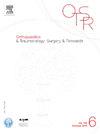Is there a cardiovascular risk associated with the use of fluoroquinolones for the treatment of osteoarticular infections? Analysis of a retrospective cohort of 817 patients from a surgical and infectious disease referral center (CRIOAC)
IF 2.2
3区 医学
Q2 ORTHOPEDICS
引用次数: 0
Abstract
Introduction
Bone joint infection is a rare but serious complication, the treatment of which most often requires intervention combined with prolonged high-dose antibiotic therapy. Fluoroquinolones are among the standard antibiotics for the treatment of these infections, particularly in combination with rifampicin for staphylococcal infections and as monotherapy for Gram-negative bacilli infections. However, recent studies, confirmed by several meta-analyses, have highlighted an increased cardiovascular risk such as aortic aneurysm and mitro-aortic regurgitation occurring early following fluoroquinolone use, leading to recommendations for caution from health agencies. These meta-analyses are often based on limited series with numerous indication biases (variable treatment durations) and low doses. We therefore conducted a single-center, single-prescriber, real-life study of a continuous series of osteo-articular infections. The objectives were to determine the rate of cardiovascular events (aortic aneurysm, mitro-aortic regurgitation) at 60 days, the mortality rate at 60 days, and at the final follow-up.
Hypothesis
Our hypothesis was that despite long-term, high-dose treatments, there was no increased cardiovascular risk in patients treated for osteo-articular infections with fluoroquinolones.
Materials and methods
Between 2017 and 2019, 817 patients were treated at the CRIOAC (Referral Center for Complex Osteo-Articular Infections) Lille-Tourcoing (332/817 patients received treatment with fluoroquinolones). This retrospective cohort study assessed the onset or worsening of cardiovascular events (such as aortic aneurysms and mitro-aortic regurgitation) and death at 2 months using a propensity score.
Results
After propensity score weighting, there was no significant difference in the risk of aortic aneurysm and mitro-aortic regurgitation at 60 days (Odds ratio (OR) 0.921 [0.317; 2.673], p = 0.879) or in the risk of death at 60 days (OR 1.252 [0.502; 3.118]; p = 0.630). There was also no significant difference in the risk of death at last follow-up after propensity score weighting (OR 1.011 [0.646; 1.582], p = 0.962).
Discussion
The results of this study suggest that the use of fluoroquinolones in patients treated for osteoarticular infections does not pose a significant increased risk of aortic aneurysm, mitro-aortic regurgitation, or death within two months. We believe it is reasonable to continue prescribing fluoroquinolones for osteoarticular infections while maintaining surveillance for these events.
Level of evidence
III; case-control study with propensity score.
使用氟喹诺酮类药物治疗骨关节感染是否存在心血管风险?对来自外科和传染病转诊中心(CRIOAC)的817例患者进行回顾性队列分析
骨关节感染是一种罕见但严重的并发症,其治疗通常需要干预联合长期大剂量抗生素治疗。氟喹诺酮类药物是治疗这些感染的标准抗生素之一,特别是与利福平联合治疗葡萄球菌感染和作为革兰氏阴性杆菌感染的单一疗法。然而,最近的研究,经几项荟萃分析证实,强调了氟喹诺酮类药物使用后早期发生的心血管风险增加,如主动脉瘤和微主动脉反流,导致卫生机构建议谨慎使用。这些荟萃分析通常基于有限的系列,有许多适应症偏差(治疗持续时间可变)和低剂量。因此,我们对一系列连续的骨关节感染进行了单中心、单处方、真实的研究。目的是确定60天时心血管事件(主动脉瘤、小主动脉反流)的发生率、60天和最后随访时的死亡率。假设:我们的假设是,尽管长期高剂量治疗,氟喹诺酮类药物治疗骨关节感染的患者心血管风险并未增加。材料和方法:2017年至2019年,817例患者在CRIOAC(复杂骨关节感染转诊中心)Lille-Tourcoing接受治疗(332/817例患者接受氟喹诺酮类药物治疗)。这项回顾性队列研究使用倾向性评分评估2个月时心血管事件(如主动脉瘤和微主动脉反流)的发生或恶化以及死亡情况。结果:倾向评分加权后,两组患者在60天发生主动脉瘤和小主动脉反流的风险无显著差异(优势比(OR) 0.921 [0.317;2.673], p = 0.879)或60天死亡风险(or 1.252 [0.502;3.118);p = 0.630)。倾向评分加权后最后一次随访时的死亡风险也无显著差异(OR 1.011 [0.646;1.582], p = 0.962)。讨论:本研究的结果表明,治疗骨关节感染的患者使用氟喹诺酮类药物不会显著增加主动脉瘤、微主动脉反流或两个月内死亡的风险。我们认为继续使用氟喹诺酮类药物治疗骨关节感染是合理的,同时保持对这些事件的监测。证据等级:III;有倾向评分的病例对照研究。
本文章由计算机程序翻译,如有差异,请以英文原文为准。
求助全文
约1分钟内获得全文
求助全文
来源期刊
CiteScore
5.10
自引率
26.10%
发文量
329
审稿时长
12.5 weeks
期刊介绍:
Orthopaedics & Traumatology: Surgery & Research (OTSR) publishes original scientific work in English related to all domains of orthopaedics. Original articles, Reviews, Technical notes and Concise follow-up of a former OTSR study are published in English in electronic form only and indexed in the main international databases.

 求助内容:
求助内容: 应助结果提醒方式:
应助结果提醒方式:


